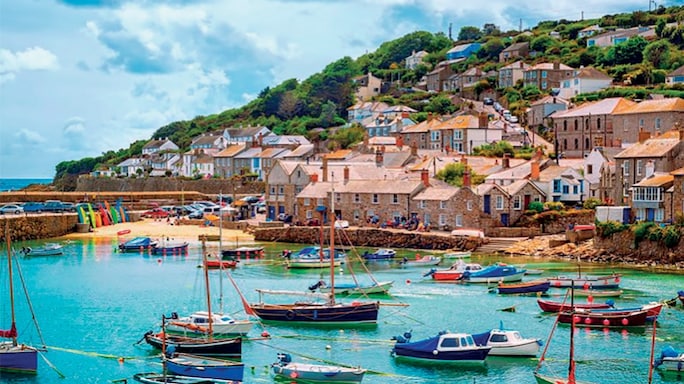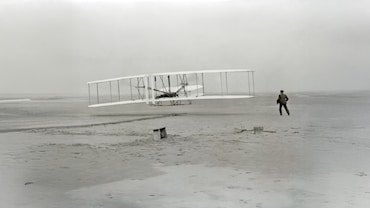A Sojourn through Smuggler's Cove
Behind Cornwall’s charming coastal villages lies an infamous, seafaring past
 Located between Lands End and Penzance, Mousehole is still home to a working harbour and small wooden fishing boats still line the quay today. Photo: Courtesy of visit cornwall.
Located between Lands End and Penzance, Mousehole is still home to a working harbour and small wooden fishing boats still line the quay today. Photo: Courtesy of visit cornwall.
A striking, 1930 topsail schooner, dubbed Anny, looms large over a small fleet of square riggers that pepper the blue waters of the Charlestown Harbour in Cornwall, UK. Along with the Kajsamoor, a two-masted ketch built in 1939, this Danish-built, fishing boat turned daysailing flagship takes pride of place at the renowned UNESCO World Heritage Site, ready to take to the seas. The vessels are anchored not far from a row of charming Georgian buildings that sit cheek by jowl with tiny fishermen’s cottages. Gazing at the towering ship’s masts and quaint, slant-roofed cottages, I am jolted by the feeling of having stepped back in time. Could I have turned back the clock?
My fascination with Cornwall began when I first read about it in a Famous Five adventure by Enid Blyton many moons ago. So, when a chance to travel to this ceremonial county came along, I grabbed it. My pre-travel research revealed that the foundation of Charlestown was laid between 1791 and 1801 by Charles Rashleigh, a local landowner, who constructed the port to export copper and China clay—Cornwall’s ‘white gold’—from local mines. As I explore the harbour on foot centuries later, my mind pictures the small port bustling with the arrival and departure of ships and boats in the early 1800s. I soon find however that the history of Cornwall truly comes alive in its small seaside villages where piracy—and later smuggling—thrived. The Shipwreck Treasure Museum in Charlestown may have closed down, but many locals keep a wealth of stories about the region’s seafaring past.
 More than 20 films and TV series have been shot at Charlestown, including Tim Burton’s Alice in Wonderland, an episode of Dr. Who and the BAFTA award-winning movie Bait. Photo: Alamy
More than 20 films and TV series have been shot at Charlestown, including Tim Burton’s Alice in Wonderland, an episode of Dr. Who and the BAFTA award-winning movie Bait. Photo: Alamy
At St. Agnes, an unspoilt village considered the essence of rural Cornwall, I learn more about how the area’s strategic location along major shipping routes and a tough-to-navgiate coastline made this now popular tourist destination an ideal base for pirates out to plunder ships and evade capture.
“The numerous natural caves and coves offered pirates the perfect spots to secretly moor their ships; the region’s proximity to the ocean let them intercept ships traversing to and from Europe, America, and Africa,” says Ben Davies, who mans a small art gallery.
Boats also routinely crossed the channel between Cornwall and France, bringing back goods like tea, spirits, silk, and lace. The infamous pirates who operated in the region included legendary names such as Captain Henry Avery, John ‘Calico Jack’ Rackham, whose crew included Anne Bonny and Mary Read, and John ‘King of Prussia’ Carter.
After the Golden Age of piracy, from the late 17th to early 18th century, declined, the villages of Cornwall became fertile ground for the next big maritime underground enterprise—smuggling—due to a number of factors, including extreme poverty, heavy taxations, the region’s convenient terrain, and an inability to enforce the rule of law. Industrious fishermen and impoverished labourers slowly turned to smuggling to support their families and soon ‘free trade’ became an important part of Cornwall’s underground economy, employing families and communities. Men brought in the contraband; women and children were often complicit in storage, sale, and distribution.
 Polperro was once a major pirate’s hub and local legends describe hidden tunnels under the village, ghosts of headless smugglers charging through the streets on horseback. Photo: Courtesy of visit cornwall.
Polperro was once a major pirate’s hub and local legends describe hidden tunnels under the village, ghosts of headless smugglers charging through the streets on horseback. Photo: Courtesy of visit cornwall.
It was the same in Polperro, a historic smuggling village with spectacular views of land and sea. “Our town was probably a stronghold of the contraband trade in early times … The place was especially adapted to its successful prosecution,” writes Polperro-born, British scientist and naturalist Jonathan Couch in his book, The History of Polperro. “A commodious creek led into a deep and secluded valley, of very difficult approach by land, where lived a race of hardy and reckless sailors and amphibious artisans for whom a life of adventure and great, though precarious, profits had many charms.”
Willy Wilcox’s Cave, located beyond the harbour walls, played a key role for a range of goods, both prized (such as gin and brandy) and quotidian (such as salt), were smuggled in. The villagers used salt to cure oily fish such as pilchards, which were caught in the thousands by the shore and comprised their staple diet throughout the year.
Much like pirates, smugglers relied on stealth, secrecy, and the bountiful nooks and corners afforded by Cornwall’s sea-battered coastline. They were often aided by wreckers who made a living by deliberately guiding ships on to the shore with a false light, and helped facilitate the capture of sought-after goods like tobacco, rum, and silk, Davies says.
Mousehole (pronounced mow-zell), nestled on the shores of Mount’s Bay, seems idyllic—it was once described by poet Dylan Thomas as “the loveliest village in England”. Winding streets adorned with flower-filled cottages, art galleries and cosy cafes lead to the harbour wall and stunning views of the bay. But the narrow streets and hidden alleys once provided the perfect cover for illicit activities.
 Museums and pirate-themed pubs in Cornwall pay homage to its nefarious history. Photos: Alamy
Museums and pirate-themed pubs in Cornwall pay homage to its nefarious history. Photos: Alamy
Only a few kilometres from Penzance, this sleepy village was invaded by a small Spanish armada in 1595. “Decades later, it became involved in the trade that Cornwall’s geography facilitated,” says the woman at the till at the Mousehole Gift Shop. The Old Watch House, built in the early 1800s for the watchman who kept an eye out for smugglers and monitored movement in the harbour, has now been remade into a cosy hotel.
The Ship Inn, a historic pub directly opposite the harbour, offers the best ending to my day: fresh mussels in a lobster-and-dill sauce. My server suggests I return in December for the village and harbour’s iconic Christmas lights.
The romantic allure of Cornish ‘free trade’ may be gone, but the Cornish people have kept their past alive through tourism. Many of them speak fondly of natural land formations with evocative names like Pepper Cove, Hell’s Mouth and Ralph’s Cupboard, and tell tales of notorious Cornishmen, including Polperro’s Zephaniah Job, a schoolmaster turned ‘smuggler’s banker’; John Carter, who ran a smuggling enterprise with his brothers for 30 years and was known for his “honest dealings”; and Henry Cuttance, who reportedly detailed his stock and sales of smuggled goods in a book.
Steeped in legend and folklore, Cornwall’s pirate and smuggling history is an integral part of its past, but continues to dominate the present—visible in the names of houses like Smuggler’s Cove and Hidden Cove, pubs like Smuggler’s Rest and the Lamorna Wink, lodgings like Smuggler’s Inn and Jamaica Inn; on walking tours such as Smuggler’s Way, Cornish Smugglers’ East Tour, and Newquay Smugglers Walk; in museums such as the Smuggling Museum in Bodmin Moor and Harbour Heritage Museum in Polperro, and the many smuggling-themed festivals held across the county.
Cornwall may no longer be a hotbed of smuggling, but the shadow of bygone days looms large. The small fishing villages, their intrinsic ties to the sea, and the audacious exploits of seafaring men in the past seem integral to Cornwall’s narrative in the present.






